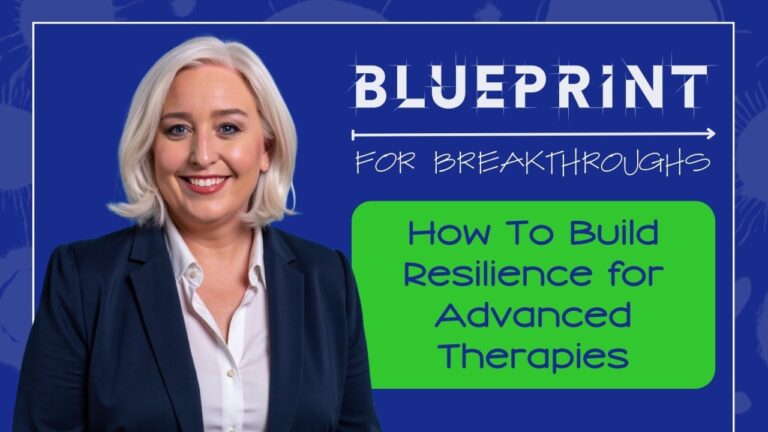Originally published as “How To Build Resilience for Advanced Therapies with Supply Chain and Resource Planning”on LinkedIn on March 25, 2025
Blueprint for Breakthroughs is a LinkedIn newsletter published by Adrienne B. Mendoza, MHA, SVP BioBridge Global and Chief Operating Officer (COO), BBG Advanced Therapies
You might agree that every therapy’s promise relies not only on great science but also on the ability to deliver it, safely, reliably, and at scale. In cell and gene therapy, where starting materials can be perishable and personalized, the stakes are higher and the risks, are more hidden. Supply chain and resource planning can build resilience for advanced therapies.
To explore this topic, I teamed up with Jared Young, Director of Resource Management at BBG Advanced Therapies, who leads capacity planning, facility forecasting, and supplier strategy across our operations. With a decade of experience in logistics, production scheduling, and supply chain systems, Jared knows how seemingly small missteps early in the planning cycle can cascade into costly delays later on, so that’s why he’s focused his efforts to ensure that those potential risks are mitigated for our partners and our organization, right from the start.
In this article, together, we discuss how early-stage biotech teams can build resilience, not just in their science, but in the systems that bring it to life.
The High Stakes of Fragile Supply Chains
Advanced therapy development relies on a tightly coordinated network of materials, equipment, personnel, and cold-chain logistics. A single gap, a delayed reagent, a missing consumable, an unvalidated courier route, can disrupt an entire production run.
“Many early programs underestimate just how much coordination it takes,” Jared noted. “They focus on the protocol and the science, and assume the materials and infrastructure will scale with them. But that’s rarely the case unless you plan for it intentionally.”
When supply chain issues hit, they rarely come in isolation. They disrupt production, delay trial enrollment, stretch investor timelines, and increase regulatory risk.
Lessons from Other Industries
We’ve seen what happens when supply chains aren’t designed to flex:
- The Semiconductor Shortage (2020–2022): Global chip delays brought the automotive sector to a halt. A reliance on lean, just-in-time inventories meant companies had little buffer when disruption hit.
- The U.S. Infant Formula Crisis (2022): When one key manufacturing facility was shut down, lack of redundancy in the supply chain triggered national shortages.
- Pharmaceutical API Constraints During COVID-19: Overdependence on geographically concentrated suppliers exposed how a fragile upstream network can stall downstream production.
The lesson for the Advanced Therapies field? Fragility doesn’t just delay operations, it erodes trust and limits a product’s ability to reach the patients who need it.
Where Cell and Gene Therapy Supply Chains Are Most Vulnerable
Based on Jared’s work leading cross-functional forecasting and facility alignment, here are four key pressure points that deserve attention early:
Single-Supplier Dependencies
Critical materials like buffers, reagents, vectors, or custom disposables are often sourced from one vendor. But if that vendor faces a capacity issue or quality lapse, there may be no short-term backup.
Uncoordinated Cold Chain Logistics
Critical materials like buffers, reagents, vectors, or custom disposables are often sourced from one vendor. But if that vendor faces a capacity issue or quality lapse, there may be no short-term backup.
Uncoordinated Cold Chain Logistics
Patient-derived starting material, like leukopaks, requires validated cryopreservation and temperature control. Gaps in process handoff or courier protocols can compromise cell viability and chain-of-identity assurance.
Disconnected Forecasting and Production Planning
When material planning, personnel scheduling, and cleanroom utilization aren’t coordinated, a facility can look available on paper, but be functionally unavailable due to upstream constraints.
Lack of Real-Time Visibility
Without robust systems to track inventory, release timelines, and batch status, teams struggle to course-correct quickly when issues arise.
What Early Resilience Looks Like
Designing supply chain resilience into your therapy development plan doesn’t require doubling budgets; it requires anticipating what’s needed to scale safely and sustainably.
Here are some foundational practices we’ve implemented at BBG Advanced Therapies, based on Jared’s planning framework:
- Cross-Functional Forecasting Models: We integrate program timelines, material needs, and production suite availability in real time, allowing proactive resourcing weeks or months in advance.
- Dual-Source Material Strategies: Even during early process development, we encourage validation of secondary suppliers for critical inputs. Yes, it takes time, but it prevents expensive bottlenecks later.
- Digital Inventory and Document Systems: Our quality and supply teams rely on integrated systems that align electronic batch records, material release timing, and training certifications, helping our customers avoid unnecessary delays.
- Adaptable Infrastructure: We designed our facilities and cleanroom operations with flexibility in mind, allowing us to support both autologous and allogeneic workflows, and centralized and decentralized models.

Supply Chain Readiness Signals Organizational Maturity
Jared put it well:
“Investors and partners want to see more than science – they want to see a team that’s ready to deliver. When a biotech company shows that they’ve thought through the resource plan, the material flow, the vendor risks, that’s when people take them seriously.”
Early supply chain planning doesn’t just reduce risk, it builds credibility. It demonstrates that your organization is thinking not just about what you’re building, but how you’ll scale it.
Final Thoughts: Building the Bridge Between Discovery and Delivery
Cell and gene therapy companies are under pressure to accelerate timelines and preserve cash. But cutting corners in supply chain planning often costs more in the long run, through delays, lost batches, or impeded regulatory findings.
At BBG Advanced Therapies, we’ve designed our operations to support innovators through both foresight and flexibility. As a full-service CTDMO, we offer the tools, systems, and experience to help them move forward with confidence. As you partner for lifesaving innovation, we help ensure resiliency is integrated into your program, right from the start.
In the end, resilience is about effectively anticipating disruption and building the right habits, systems, and strategies that ensure therapies ultimately reach the clinic and work effectively for the patients depending on them.
Feel free to connect through LinkedIn as a direct message, or through our website at BBGAT.org
Cheers to Resiliency!




